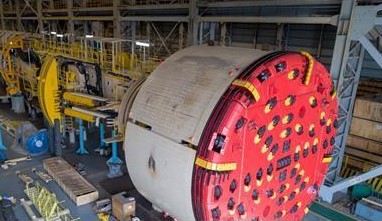An open-type TBM (Tunnel Boring Machine) is a key type of tunnel boring machine (TBM). Its core characteristic is its lack of a closed shield and relatively open structure, relying primarily on the inherent stability of the surrounding rock to complete tunneling and initial support operations. It exhibits significant advantages in tunnel construction under specific geological conditions. The following details its application scenarios and core advantages:

I. Main Applications of Open-Type TBMs
The application of open-type TBMs is highly dependent on geological conditions. Its primary application is in hard rock formations with good stability and integrity. Specific project types include:
1. Mountain Tunnels: These include long railway and highway tunnels through mountainous areas (a typical example is the use of an open-type TBM in sections of the Qinling Zhongnanshan Highway Tunnel in my country). The surrounding rock in these projects is often hard rock, such as granite and sandstone, which has good integrity and can achieve short-term self-stability without the need for strong support.
2. Water conservancy and hydropower tunnels: These include diversion tunnels and power generation tunnels (e.g., the Jinping II Hydropower Station diversion tunnel). Hard rock formations prevent surrounding rock collapse during excavation, making them suitable for efficient open-type TBM construction.
3. Mining tunnels: These are transportation or ventilation tunnels used in some deep mineral resource extraction operations. If the surrounding rock is stable and hard, open-type TBMs can be used to minimize disturbance to the ore body.
II. Core Advantages of Open-Type TBMs
Compared to shield-type TBMs (such as earth pressure balance (EPB) and slurry shields, which are suitable for soft rock or complex formations), open-type TBMs offer significant advantages in hard rock tunnel construction, primarily in the following aspects:
1. Extremely High Hard Rock Construction Efficiency
The cutterhead design of an open-type TBM is optimized for hard rock. Cutters (such as disc cutters) directly crush the rock through compression and shearing. Combined with an efficient mucking system (such as a belt conveyor), it can achieve daily advances of 10-30 meters in intact hard rock, far exceeding drill and blast methods (typically 1-3 meters per day). This makes it particularly suitable for long tunnels (over 5 kilometers) and significantly reduces construction schedules.
2. Simple Structure and Lower Cost
With no enclosed shield or complex segment assembly system, the mechanical structure is simpler, resulting in manufacturing and procurement costs 20%-30% lower than those of a shield-type TBM of the same diameter. Furthermore, maintenance is simplified (fewer vulnerable parts, such as hydraulic lines and sealing systems), significantly reducing ongoing operating costs.
3. Flexible support system adapts to changing surrounding rock mass
The open nature of an open-type TBM allows construction workers to directly observe the surrounding rock mass at the tunnel face and adjust support measures (such as shotcrete, anchors, and steel arches) based on real-time geological conditions, rather than relying on fixed segments. For example, if local surrounding rock integrity deteriorates, support strength can be quickly increased, avoiding the limitations of the rigid segment support of shield-type TBMs.
4. Wide-open working space and greater safety
Without shield obstruction, the tunnel face connects to subsequent work areas (support, mucking, and equipment maintenance), facilitating operator operation and equipment scheduling. Furthermore, the inherent stability of hard rock formations, combined with real-time support, reduces the risks of collapse and water inrush (assuming the geological conditions meet).
5. Strong Adaptability to Tunnel Cross-Sections
The cutterhead and machine body design are flexibly adjustable, enabling the creation of various cross-sections, such as circular and horseshoe shapes, to meet the requirements of different projects (e.g., widening a highway tunnel). Shield-type TBMs, however, are limited by their shields and are difficult to adjust.
Open-type tunnel boring machines are highly effective tools for hard rock tunnel construction. Their application relies on stable hard rock formations. Their core advantages lie in efficiency, cost, and flexibility. They are particularly well-suited for long-distance hard rock tunneling projects, such as those in mountainous areas and water conservancy projects, and are a key technology choice for modern mechanized tunnel construction.





